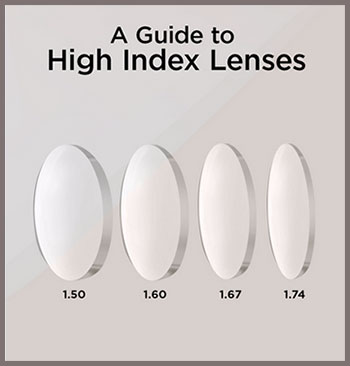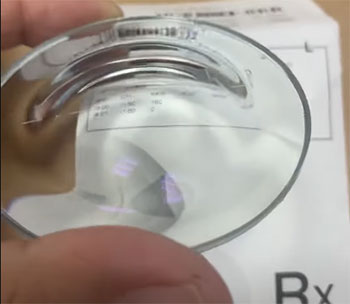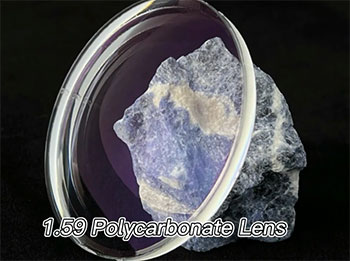When it comes to choosing the perfect lenses for your eyewear, you might find yourself caught between two popular options: 1.67 high index lenses and polycarbonate lenses.
Both have their merits, but which one is truly the best fit for your needs? Let’s dive into the world of these lens materials and explore their unique characteristics, pros, and cons to help you make an informed decision.
A Brief Comparison Table
| Feature | 1.67 High Index Lenses | Polycarbonate Lenses |
| Refractive Index | 1.67 | 1.59 |
| Thickness | Thinner | Thicker |
| Impact Resistance | Good | Excellent |
| UV Protection | 100% | 100% |
| Scratch Resistance | Good | Fair |
| Weight | Lighter | Light |
| Cost | Higher | Lower |
| Suitable for | High prescriptions | Sports, children |
| Abbe Value (Clarity) | 32 | 30 |
Now that we’ve got a bird’s eye view of the comparison, let’s roll up our sleeves and explore these lens options in more detail.
Understanding 1.67 High Index Lenses
What Are High Index Lenses?

Picture this: you’ve just been told you need a strong prescription, and you’re worried about ending up with those thick, heavy glasses that make you feel like you’re wearing magnifying glasses. Enter high index lenses – the superhero of the optical world!
High index lenses are made from advanced plastic materials that have a higher refractive index than standard plastic lenses. In simple terms, they can bend light more efficiently, which means they can correct your vision with less material. The result? Thinner, lighter lenses that don’t make you feel like you’re carrying a small aquarium on your face.
The 1.67 High Index Lens: A Closer Look
The 1.67 high index lens is a popular choice among the high index family. It strikes a nice balance between thinness, lightness, and affordability compared to even higher index options like 1.74.
Pros of 1.67 High Index Lenses
- Slim and Trim: Let’s face it, nobody wants to rock the “coke bottle” look. 1.67 high index lenses can be up to 40% thinner than standard plastic lenses, giving your glasses a sleek, modern appearance.
- Light as a Feather: With less material comes less weight. Your nose and ears will thank you for choosing these lightweight wonders, especially if you wear your glasses all day.
- High Prescription Hero: Got a strong prescription? No problem! These lenses can handle high prescriptions without bulking up, making them ideal for people with significant vision correction needs.
- UV Protection: Like a built-in pair of sunglasses, 1.67 high index lenses offer 100% UV protection. Your eyes will be shielded from harmful rays without any extra coatings.
- Versatile Styling: The thinness of these lenses means they can fit into a wider range of frame styles, including those trendy rimless and semi-rimless options.
Cons of 1.67 High Index Lenses

- Cost Considerations: Quality comes at a price. 1.67 high index lenses are typically more expensive than standard plastic or polycarbonate options.
- Potential for Edge Glare: Due to their higher refractive index, these lenses can sometimes produce more noticeable edge reflections. However, a good anti-reflective coating can mitigate this issue.
- Slightly Lower Abbe Value: With an Abbe value of 32, 1.67 high index lenses may have slightly more chromatic aberration (color fringing) than lower index lenses. However, this is usually not noticeable in everyday use.
- Care Required: While these lenses are durable, they’re not indestructible. They may require a bit more care to avoid scratches compared to some other lens materials.
Polycarbonate Lenses: The Tough Guy of the Optical World
What Are Polycarbonate Lenses?
Imagine a lens material so tough, it’s used in astronaut helmet visors and fighter jet canopies. That’s polycarbonate for you! Developed in the 1970s, polycarbonate quickly became a go-to material for safety glasses and sports eyewear due to its incredible impact resistance.
Polycarbonate Lenses: Strengths and Weaknesses
Pros of Polycarbonate Lenses
- Tough as Nails: If you’re prone to dropping your glasses or you have an active lifestyle, polycarbonate lenses are your best friend. They’re virtually shatter-proof, making them ideal for sports, children’s eyewear, and safety glasses.
- Lightweight Comfort: While not as light as 1.67 high index lenses, polycarbonate is still significantly lighter than standard plastic or glass lenses.
- UV Protection Champion: Like their high index counterparts, polycarbonate lenses offer 100% UV protection, keeping your eyes safe from harmful rays.
- Cost-Effective: Generally more affordable than high index options, polycarbonate lenses offer a good balance of performance and value.
- Thinner Than Standard Plastic: With a refractive index of 1.59, polycarbonate lenses are about 20-25% thinner than standard plastic lenses.
Cons of Polycarbonate Lenses

- Scratch Prone: The soft nature that makes polycarbonate impact-resistant also makes it more susceptible to scratches. A good scratch-resistant coating is a must.
- Lower Abbe Value: With an Abbe value of 30, polycarbonate lenses may have slightly more chromatic aberration than some other lens materials.
- Not Ideal for Very High Prescriptions: While thinner than standard plastic, polycarbonate may not be thin enough for very strong prescriptions without resulting in thicker edges.
- Potential for Internal Stress: The manufacturing process can sometimes lead to internal stress in the lens, which may affect optical quality in some cases.
The Showdown: 1.67 High Index vs Polycarbonate
Now that we’ve got the lowdown on both lens types, let’s pit them against each other in a head-to-head comparison. It’s like a WWE match, but for eyewear!
Thickness and Weight
In the battle of the bulge, 1.67 high index lenses come out on top. They’re about 15-20% thinner than polycarbonate lenses, which can make a noticeable difference, especially for stronger prescriptions. If you’re looking for the sleekest profile possible, 1.67 high index is the way to go.
When it comes to weight, both lens types are significantly lighter than standard plastic or glass. However, 1.67 high index lenses have a slight edge, being a tad lighter than polycarbonate. If you’re sensitive to weight on your nose or ears, this might be the deciding factor.
Durability and Impact Resistance
Here’s where polycarbonate flexes its muscles. While 1.67 high index lenses are certainly no weaklings, polycarbonate is the undisputed champion of impact resistance. If you’re buying glasses for a child, an athlete, or someone who’s tough on their eyewear, polycarbonate is the clear winner.
That said, 1.67 high index lenses are no slouch in the durability department. They’re more than capable of standing up to everyday wear and tear. But if you’re worried about your glasses taking a direct hit from a rogue baseball, polycarbonate is your best bet.
Optical Clarity
This is where things get a bit technical. Both lens types have relatively low Abbe values (32 for 1.67 high index and 30 for polycarbonate), which means they can potentially cause more chromatic aberration than some other lens materials. In practical terms, this might manifest as slight color fringing around the edges of your vision, especially in high-contrast situations.
However, the difference between the two is minimal, and most wearers don’t notice any issues in everyday use. If optical clarity is your top priority, you might want to consider other lens materials with higher Abbe values, but for most people, both 1.67 high index and polycarbonate lenses provide satisfactory clarity.
UV Protection
It’s a tie! Both lens types offer 100% UV protection, shielding your eyes from harmful ultraviolet rays. This is a crucial feature for maintaining long-term eye health, so it’s great that both options have you covered.
Cost Considerations
If you’re watching your wallet, polycarbonate lenses generally have the advantage. They’re typically less expensive than 1.67 high index lenses, making them a popular choice for budget-conscious buyers.
However, it’s important to consider the long-term value. If you have a strong prescription, the extra thinness of 1.67 high index lenses might be worth the additional cost, especially if it means you can choose from a wider range of frame styles.
Prescription Range
For those with milder prescriptions, both lens types will work well. But if you’re rocking a strong prescription (generally +/-4.00 diopters or more), 1.67 high index lenses start to show their strengths. They can provide a thinner, more aesthetically pleasing result for high prescriptions without the “coke bottle” effect.
Polycarbonate can handle a wide range of prescriptions too, but for very strong prescriptions, you might end up with thicker edges or more noticeable magnification/minification effects.
Also Read: 1.6 Vs. 1.67 Lenses: Ultimate Showdown for Crystal Clear Vision
Making Your Choice: Factors to Consider
Choosing between 1.67 high index and polycarbonate lenses isn’t just about the specs – it’s about your lifestyle, preferences, and specific vision needs. Here are some key factors to consider:
- Prescription Strength: If you have a strong prescription, especially +/-4.00 diopters or more, 1.67 high index lenses might be the better choice for achieving the thinnest possible lenses.
- Lifestyle and Activities: Are you an athlete or someone with an active lifestyle? Do you work in an environment where impact resistance is crucial? If so, polycarbonate might be the way to go.
- Children’s Eyewear: For kids’ glasses, the impact resistance of polycarbonate is hard to beat. Kids can be tough on their eyewear, and polycarbonate can stand up to the challenge.
- Budget: If cost is a major concern, polycarbonate lenses are generally more affordable. However, consider the long-term value and whether the extra cost of 1.67 high index lenses might be worth it for your specific needs.
- Frame Selection: If you have your heart set on rimless or semi-rimless frames, the thinness of 1.67 high index lenses might be necessary to achieve the look you want.
- Sensitivity to Weight: If you find heavier glasses uncomfortable, the slightly lighter weight of 1.67 high index lenses might make a noticeable difference in all-day comfort.
- Occupational Hazards: If you work in an environment where eye protection is crucial, the superior impact resistance of polycarbonate might be the deciding factor.
The Verdict: Is There a Clear Winner?
After diving deep into the world of 1.67 high index and polycarbonate lenses, you might be wondering if there’s a clear champion. The truth is, there’s no one-size-fits-all answer. Both lens types have their strengths, and the best choice depends on your individual needs and circumstances.
1.67 high index lenses shine when it comes to thinness and lightness, making them ideal for strong prescriptions and those who prioritize aesthetics and comfort. They’re the go-to choice for fashion-conscious individuals who don’t want their prescription to limit their frame options.
Polycarbonate lenses, on the other hand, are the undisputed kings of durability and impact resistance. They’re perfect for active lifestyles, children’s eyewear, and anyone who values peace of mind when it comes to their glasses’ ability to withstand accidental drops or impacts.
Both options offer excellent UV protection and are significantly better than standard plastic lenses in terms of thickness and weight. The choice often comes down to balancing factors like prescription strength, lifestyle needs, and budget considerations.
FAQ: Your Burning Questions Answered
The main differences lie in their refractive index, impact resistance, and thickness. Polycarbonate lenses have a refractive index of 1.59 and are known for their excellent impact resistance, making them ideal for sports and children’s eyewear.
1.67 high index lenses have a higher refractive index of 1.67, allowing them to be thinner and lighter, especially for stronger prescriptions. While both are thinner than standard plastic lenses, 1.67 high index lenses can be up to 15-20% thinner than polycarbonate for the same prescription.
One significant drawback to high index glass lenses (which are different from the plastic 1.67 high index lenses we’ve been discussing) is their weight and fragility. High index glass lenses are much heavier than their plastic counterparts, which can make them uncomfortable for all-day wear.
They’re also more prone to shattering upon impact, making them a poor choice for active lifestyles or children’s eyewear. This is why plastic high index lenses, like the 1.67 we’ve been discussing, have largely replaced glass in most applications.
Yes, high index lenses, including 1.67 high index, are typically more expensive than polycarbonate lenses. The advanced materials and manufacturing processes used to create high index lenses contribute to their higher cost.
However, many wearers find the extra expense worthwhile for the thinner, lighter lenses, especially those with stronger prescriptions. The price difference can vary depending on the specific product and retailer, so it’s always a good idea to compare options and consider the long-term value.
Whether you should upgrade to polycarbonate lenses depends on your specific needs and circumstances. Polycarbonate can be a great upgrade from standard plastic lenses if you:
Need impact-resistant lenses for sports or an active lifestyle
Are buying glasses for a child
Work in an environment where eye protection is important
Want lenses that are thinner and lighter than standard plastic (though not as thin as high index options)
Desire built-in UV protection
However, if you have a very strong prescription and lens thickness is your primary concern, you might want to consider high index lenses instead. Always consult with your eye care professional to determine the best option for your specific prescription and lifestyle needs.
Also Read: 1.50 Vs. 1.61 Lenses: Seeing Clearly Through the Lens of Choice
Conclusion: Your Perfect Lens Awaits
Choosing between 1.67 high index and polycarbonate lenses doesn’t have to be a headache-inducing decision. By understanding the strengths and weaknesses of each option, you can make an informed choice that suits your unique needs.
Remember, the best lens for you is the one that provides clear vision, comfortable wear, and fits your lifestyle. Whether you opt for the sleek profile of 1.67 high index lenses or the rugged durability of polycarbonate, you’re choosing a high-quality lens material that’s leagues ahead of the glasses your grandparents wore.
Don’t be afraid to discuss your options with your eye care professional. They can provide personalized advice based on your prescription and specific needs. And remember, whichever lens you choose, you’re investing in your vision and your quality of life. After all, seeing clearly and comfortably is something you’ll appreciate every single day.
So go forth, armed with knowledge, and find the perfect lenses that will help you see the world in crystal clear detail. Your eyes will thank you!
